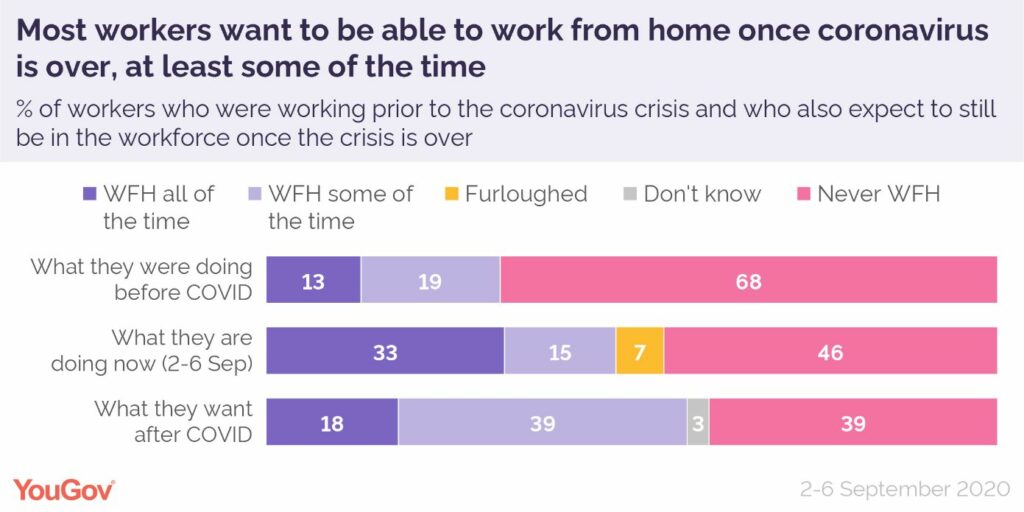In March 2020, the whole world was suddenly put on hold, everything stood still. The only people that were still leaving the house were key workers. They went to their regular place of work, although their activities probably weren’t the regular ones anymore. Everybody else stayed at home. Businesses that couldn’t provide their services through remote work received help from the government in the shape of a furlough scheme. Those workers that could perform their tasks from home were suddenly remote workers.
As lockdown restrictions were slowly and gradually lifted the guidance was still to work from home, if possible, but workers were allowed to return to the office. Some did, others stayed at home or started mixing both options – hybrid working was born!
What is hybrid working?
When we speak of a hybrid model, we are not referring to a Prius (sorry!), but to a type of flexible working arrangement where employees have the autonomy and flexibility to decide where they want to work from. The details depend on the policy of the business that adapts the hybrid working model. Most common after the pandemic is the WFH (work from home), but also the WFA (work from anywhere) is becoming more popular.
The possibilities of “anywhere” are nearly endless – it could be the coffeeshop around the corner, a co-working space, a beach, a train station or wherever the internet connection is strong enough. Your best option is certainly one of our free and unique workspaces, but we wouldn’t want to restrict your imagination!

Photo by Andrea Piacquadio from Pexels
Is hybrid working going to stay?
We have seen increased interest in hybrid working arrangements, but we have also noticed that many people were keen to return to the office as they craved social contacts. The question has emerged whether hybrid working is a model for the future or not.
When lockdown restrictions were first eased in September 2020, YouGov conducted a survey that has revealed what workers mostly want for their professional future:

Source: https://yougov.co.uk/topics/economy/articles-reports/2020/09/22/most-workers-want-work-home-after-covid-19
The biggest change lies in the percentage of people that never work from home (68% before COVID to 39% after COVID) and those that work from home some of the time (from 19% to 39%). The survey makes it obvious that there is no clear preference for office or WFH, but for the hybrid.
A report by CIPD from September 2020 summarizes what employers intend to do once the stay at home order is no longer in place: Before the pandemic, 65% of employers did not offer the option to work from home or only offered it to 10% of their workforce. After the pandemic, this is expected to decrease to 37%. This means that more employers are going to offer remote work.
When looking at these numbers, we can safely say that hybrid working is the working model of the future.
The benefits of hybrid working
If we are leaving the fact aside that most people want more flexibility these days, there are multiple reasons why businesses adopt a hybrid working model.
Below are just some of the many advantages:
- Ability to attract more talent
- Reduced costs for office space and other facilities
- Supporting inclusion and diversity
- Employee wellbeing and improved work-life balance
- Reduced commuting times for employees
- Higher levels of employee job satisfaction
- Reduced absence rates
After more than a year of remote work, most people expect more flexibility in the post-lockdown world. If an employer refuses location-flexibility, talented employees might work elsewhere. A hybrid model can also reduce employee turnover.
How to make hybrid working successful
Next to the benefits of a hybrid model we also need to look at the responsibilities and potential obstacles that it brings. If you consider these aspects early on, your hybrid arrangement will become a success story.

Photo by Austin Distel on Unsplash
Who, how and when
The first question is the who? Who in your company is eligible for hybrid working? Some job roles might have to be excluded for several reasons – it should be specified who this is. This brings up questions around fairness and inclusion that would need to be answered and explained.
The next question is the how and that requires some organisation and planning. Depending on the available office space, not every employee could be in the office at any time. You would have to specify how employees decide which days they are “in” and which days are remote. A booking management system for the desk space in the office is probably a good idea. You might also want to specify the number of days per week that employees could be in the office. There might also be certain positions that require the managers’ approval for remote days.
Then it goes on to the nitty-gritty: Does a hybrid model require employees to be online at certain times or do you measure performance on results and deliverables? With this comes a policy for meetings and attendance. Besides, you should also consider how IT equipment will be distributed and how to ensure data protection.
Communication for hybrid work teams
Communication is often a struggle and there is constantly room for improvement. A team of hybrid workers adds another layer of difficulty to it. Some team members might see each other regularly in person in the office whilst others are exclusively remote. This can easily lead to partial communication. Those in the office get their regular chats at the coffee machine and those at home are missing out on a good percentage of conversations. How to avoid that?
Probably the most important aspect is a communications tool that allows you to chat with each team member individually and in group chats. Such tools are for example Slack or Microsoft Teams (we have an Othership slack community too!). It might seem a minor thing to talk to a colleague in the hallway about a modification to the latest report, but is it really minor? Should other colleagues know what you discussed? The team should make it a habit to log work-related conversations that happen occasionally at the coffee machine or in the elevator in a team chat so that everybody has access to the information and can decide if it’s a discussion to join in or not.

Photo by Surface on Unsplash
Meetings are another aspect of communication that can easily lead to a disruption in the team. If half the team is sitting together in a room and the other half is dialling in, the remote team members can feel left out or don’t get to speak during the meeting. It is best to hold meetings in online, even if some team members sit next to each other in the office.
Not to forget is team building. The social aspect is crucial for a good work relationship. If possible, there should be regular in-person meetings. Should this not be possible, then at least a regular online social for the team to connect over something other than work.
If hybrid working is your thing, check out our free and unique workspaces and discover your WFA!





